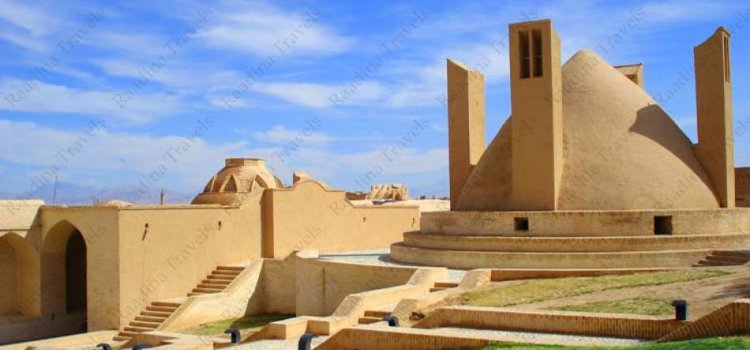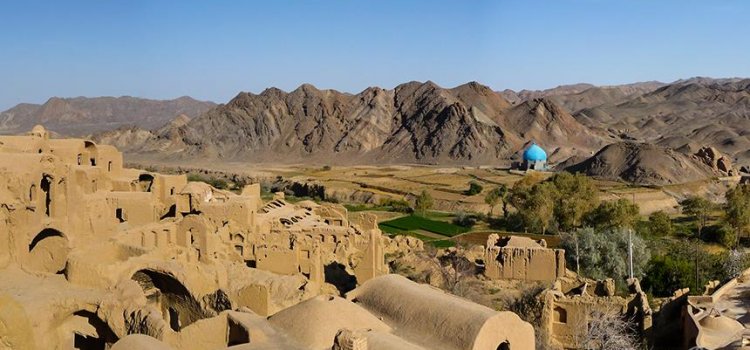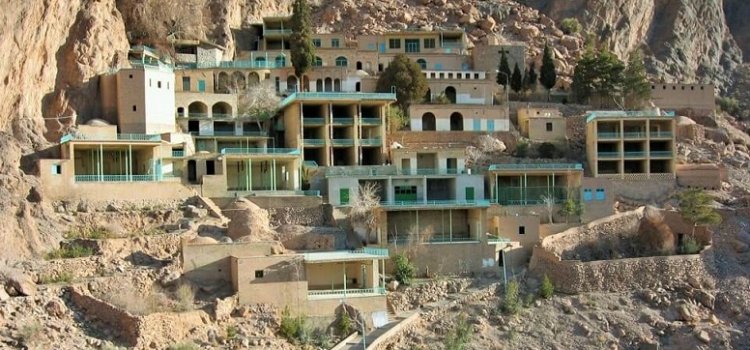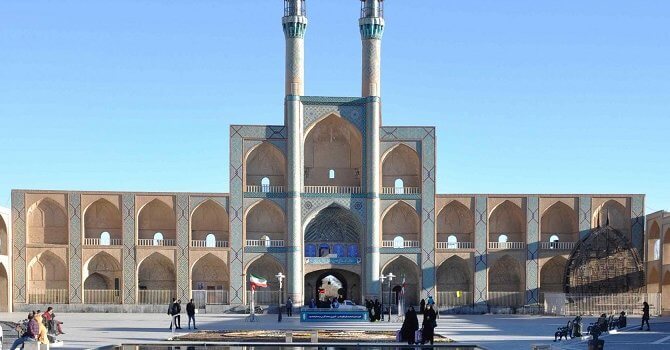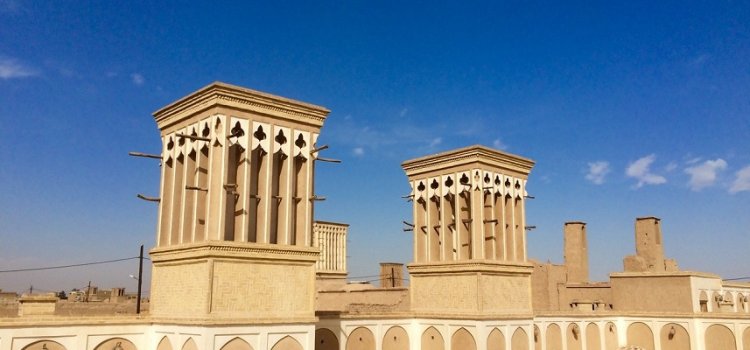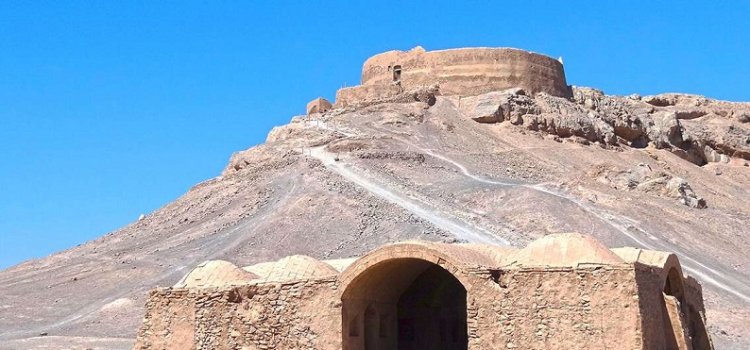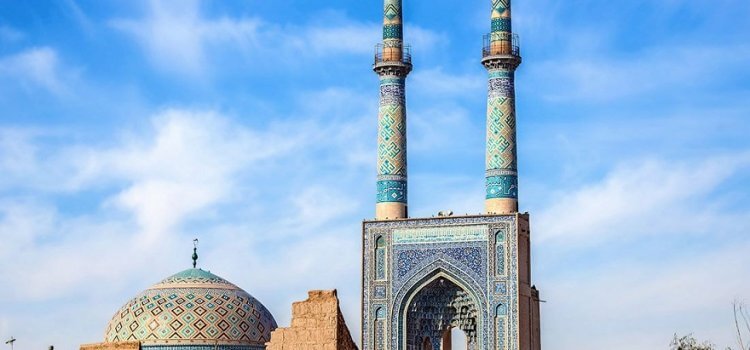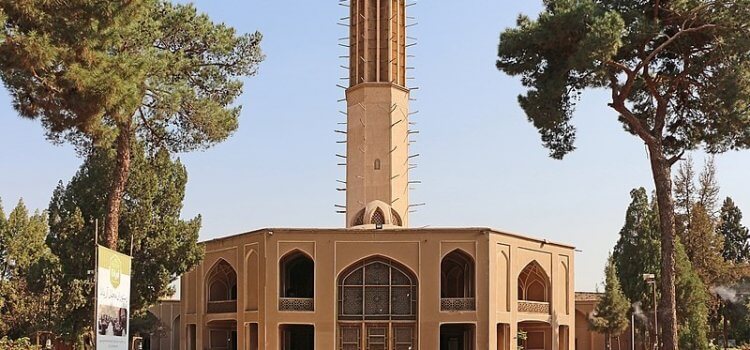Meybod
Meybod was a prosperous city during the Mozafarid era. In the 14th century, this family seized the power over a vast territory, stretching from Isfahan to Kerman, and founded its dynasty.
Meybod was a prosperous city during the Mozafarid era. In the 14th century, this family seized the power over a vast territory, stretching from Isfahan to Kerman, and founded its dynasty.
Meybod is renowned for its pottery workshops and currently constitutes an industrial center for the production of tiles for the whole country. It is 40 km from Yazd on the road to Isfahan.
A visit worth the detour to discover the remains of a complex dating from the 17th century. There is a caravanserai preceded by a small bazaar, a cistern, a post house and a ice dump.
Zilou is the special hand-woven floor-covering of Meybod. It is a kind of carpet rather woven than knotted, whose designs are made by entangling warp threads passed through the weft. Being less laborious work, the Zilous were intended to cover prayer’s rooms in mosques all over the country.
The ruins of an ancient Naring-Qaleh citadel and a pigeon tower are among other wonders to visit if time allows.
Kharanaq
Kharanaq, an ancient citadel, was a caravan relay on the road to Tabass, 80 km northeast of yazd. The visit could be part of a yazd – meybod -chakchak – Kharanaq excursion
Kharanaq, an ancient citadel, was a caravan relay on the road to Tabass, 80 km northeast of yazd. The visit could be part of a yazd – meybod -chakchak – Kharanaq excursion. A newly restored caravanserai is located right next door (For safety reasons and also to respect the privacy of residents)
Landscape differs from the desert because it is located high up and enjoys a moderate temperature.
Qanats which feed the surrounding fields are still in use.
The houses fit together and all reveal a similar architectural plan. The stables downstairs, a staircase gives access to the houses, the kitchen upstairs and windows overlook the winding streets. We see plenty of wood on the adobe roofs.
The mosque in the center of the village has a trembling minaret dating back to the 19th century.
Chak-Chak fire temple
Chak-Chak
During the Arab invasion in the mid-7th century, a Sassanid princess, Pars-banou, took to the road to flee the intruders
Chak-Chak
During the Arab invasion in the mid-7th century, a Sassanid princess, Pars-banou, took to the road to flee the intruders. During her journey, she got lost in the desert, in the company of her court. Legend has it that she disappeared into a rock, before she was captured, by her pursuers.
Since then, this place has become a sacred place and every year Zoroastrian pilgrims go there to worship.
Visiting the site allows you to admire the lunar landscape of the Yazd Desert, and above all, you can enjoy a beautiful light in the afternoon.
Amir Chakhmakh Square
Amir Chakhmaq, this is how the main square of the city of Yazd is called. It bears the name of its builder, the governor of Yazd in the 15th century, under the rein Timurid.
Amir Chakhmakh , this is how the main square of the city of Yazd is called. It bears the name of its builder, the governor of Yazd in the 15th century, under the rein Timurid.
Built as a complex, including among others a bazaar, a mosque and a cistern. Its arcaded facade with its minarets were added in the 19th century.
The changes made have given the place the appearance of Hosseinieh(
place of commemoration of the martyrdom of Imam Hossein, a high religious figure of Shiite Islam) normally constructed in Yazd.
On the square, in front of the facade with multiple arches, sits a sort of ceremonial wooden structure, this object named Nakhl (palm tree), is decorated in black during the Moharam ceremonies, and is carried on the shoulder by the men themselves dressed in black. This procession marks the culmination of the commemoration ceremonies.
Fahadan
Fahadan is the old Yazd district that constitutes the nucleus of the old city.
Fahadan: The Soul and Spirit of Oriental Adobe Neighborhoods
Have you ever watched the Disney’s “Aladdin” or played the video-game “Prince of Persia”? If so, didn’t you dream of jumping roofs along with your brave heroes to save the beautiful princess from evil hands? Yes!? So, join us to go and visit Fahadan in the city of Yazd, a neighborhood which could be the location of one these cartoons and at least partially realize your dream.
Fahadan, the largest adobe neighborhood in the world and a UNESCO World Heritage Site since 2017, is located in the heart of Yazd city. Travelers reviewing their memories from this historical neighborhood would always tell you of its long and high adobe walls, sābāts (roofed passageways), magnificent houses with marvelous wind-catchers, traditional workshops producing handicrafts and textiles, amazing mosques, religious schools and finely-decorated shrines. However, what is most striking for all of these visitors is the warm and hospitable attitude of the people living in this old neighborhood; inhabitants whose patience, hard work and perseverance has kept this old neighborhood alive, making it one of the most appealing tourist attractions in Iran.
Well, if you would like to know more about this awe-inspiring neighborhood, please continue reading our article.
Some Points You Need to Know about the Fahadan Neighborhood
Well, as the architectural style of Fahadan neighborhood reveals, it is one of the oldest neighborhoods in the city of Yazd. Based on historical evidence, this neighborhood was the residence of influential Yazdi people, thus providing us with one of the meanings of Fahadan: “Wise Men.” Also, signifying “cheetah,” it is believed that certain people in this neighborhood were in the peculiar business of training cheetahs.
The prominence of Fahadan as the beating heart of Yazd is also evident in being surrounded by significant monuments such as Bazaar-e No and Vaght-o-Sa’at Square on its southern side and Kooshk-e No and Shah Abolqasem Tomb on its western wing.
More importantly, Fahadan itself is spotted with more than 25 historical, architectural and cultural attractions, adding to its splendor and significance. In what follows, you will get acquainted with some of these gems you should not miss visiting while exploring Fahadan neighborhood.
Must-See Sights in Fahadan Neighborhood
Jameh Mosque of Yazd (the Grand Congregational Mosque of Yazd)
Just at the entrance of the Fahadan Neighborhood, there is located the Jameh Mosque of Yazd whose eye-catching beauty will no doubt mesmerize. It is believed that the mosque is founded on the ruins of a Zoroastrian fire temple, stretching its history back to pre-Islamic times.
However, what would grab your attention at first glance are the mosque’s two soaring minarets, allegedly the tallest minarets belonging to a mosque in Iran, each one 52 meters in height.
Inside, the dome chamber and its fantastic faience work make the most attractive part of the mosque. Usually, visitors spend a good deal of time taking photos while framed by these works of art to upload on their social media.
Another interesting part of the mosque is the water-cistern and its long flight of stairs, putting your fitness on trial to reach water.
Alexander’s Prison or Ziyaiyeh School
Walking through the winding alleys of Fahadan neighborhood will eventually get you to a square where some of the oldest buildings in Yazd impatiently await your visit. One of these buildings, whose history has been mixed with myth, is the Alexander Prison or Ziāiyeh School.
According to legend, having conquered the land of Persians, Alexander made up his mind to build a prison in which to keep the defeated prisoners of war. Considering different options, nowhere suited his plan better than Yazd, an arid, parched land whose geographic location made it an inaccessible land. And so Alexander’s Prison came into being.
However, it seems that the appearance of the name “Alexander’s Prison” in the historical chronicles of the Safavid period is inspired by Hafez’s famous couplet:
“I am upset over the horrors of Alexander’s Prison
Fading away to Solomon’s Kingdom”
In which the poet compares Yazd to Alexander’s Prison and Shiraz, his hometown, to Solomon’s Kingdom.
As a matter of fact, an examination of historical sources reveals that this monument was constructed as a school under the patronage of Mowlana Zia al-Din in the year 1234. Soaring high toward the sky, the adobe dome of Ziaiyeh school, decorated with splendid stucco work and water-color paintings, represents one the best pieces of architecture from the Mongol period in Iran. In addition to its dome and dome chamber, the school includes three porches, several different rooms and an underground water-cistern whose dark and scary ambience makes it look like a dungeon.
Today, the school hosts various handicraft workshops and there you can find marvelous souvenirs for your loved ones not having the opportunity to visit Iran.
The Tomb of Twelve Imams
The Tomb of Twelve Imams is one of the oldest monuments in Fahadan, built in the 11th century. The tomb has a simple quadruple plan with a brick dome. According to Arthur Upham Pope, the significance of the building lies in solving the problem of placing a semi-circular dome on a quadrilateral foundation. In the previous buildings, the area of transference was not strong enough to bear the downward pressure of a heavy dome, but in the Tomb of Twelve Imams this engineering problem is overcome in the best way possible, resulting in the construction of a perfect dome on a quadruple base.
The function of the monument is actually a bit vague. Some people believe that it is the burial place of a scared person, others are of the opinion that the building was used as a Khaneqah, or a gathering place for mystics and dervishes.
Lariha House
Lariha House is one of the most beautiful mansions in Fahadan, located in the vicinity of Alexander’s Prison and Tomb of Twelve Imams. This Qajarid (19th century) mansion was actually a complex of six houses, built by Haj Mohammad Lāri, a rich, powerful businessman from Shiraz city who came to Yazd for trade purposes.
Following the general plan of desertic houses, Lariha House boasts amazing sash windows, splendid mirror works and eye-catching paintings. The highlight of the house is its “Otagh-e Aroosi” or “Bridal Room,” decorated with European-style paintings of women.
In addition to enjoying the artistic beauties of the mansion, you will also get acquainted with traditional ways of marriage in Iran as the mansion also functions as a museum, putting on display the marriage documents of long gone couples who tied the knot years and years ago.
All in all, wandering through the winding paths of Fahadan neighborhood, visiting its historical monuments, spending some time in its traditional workshops and drinking a cup of coffee in one of its cozy coffeeshops makes one of the most pleasant days during your adventures in Iran. I am sure you would never forget your delightful moments in Fahadan Neighborhood.
Tower of Silence
Zoroastrian Dakhmeh or the tower of silence was built in 1672 in Yazd.
Yazd Towers of Silence: Two Zoroastrian Soaring Graveyards
Yazd is one of the major tourist attractions in Iran not only because of housing the largest adobe neighborhood in the world (a UNESCO World Heritage Site), but also because of hosting a Zoroastrian minority whose unique way of life has contributed largely to fame of this old city.
In another article, we have extensively talked about the Fire Temple of Yazd, the house of the ancient religion of Iran, Zoroastrianism. In this article, we are going to tell you about a Zoroastrian’s journey to his/her permanent house after life. To achieve this goal, in this article we explore the old graveyard of Zoroastrians in Yazd, called Dakhmeh (Dakhma) or Towers of Silence, and also the death rituals performed there.
So, make sure to read our article to learn whatever you need to know before setting foot in this unique Zoroastrian land of the dead, The Towers of Silence.
Khorshid Negareshi or the Zoroastrian Death Ritual
Zoroastrianism was the state religion of Iran during the rule of the Achaemenid and Sassanian dynasties. As part of their religious code, Zoroastrians believed in the purity of the four fundamental elements of the universe, that is, the air, the earth, the wind and the fire. Consequently, polluting these four essential elements was considered a grave sin.
In this context, the corpse of a dead person was considered as the greatest pollutant of the four elements. But why? Well, Zoroastrians saw a live human body as the house of a pure spirit. However, whenever the death intervened, this pure spirit left the body, giving up his abode to an impure, satanic one. Obviously, this impurity was not allowed to touch the four pure elements. Therefore, instead of burying their dead, throwing them into the water or cremating them, Zoroastrians left the dead bodies on high places to be scavenged by vultures and dried by sun and, finally, washed away from the surface of the Earth. Among Zoroastrians, this process is known as “Khorshid Negareshi” or “observed by the sun.”
To perform the ritual of “Khorshid Negareshi,” certain structures were also needed to be built. These secluded monuments, a mysterious stretch of land in the realm of death, came to be known as “Dakhmeh.”
The appellation “Towers of Silence,” used mostly by Western writers, is said to be coined by Robert Murphy, a translator for the British colonial government of India in early 19th century.
The structure of Towers of Silence
As mentioned before, towers of silence were build atop hills or low mountains, outside the surrounding villages or towns, to keep people away from poisonous gases emanating from the decomposing bodies. Generally speaking, towers of silence were circular in shape, fenced with high walls constructed out of stone and cement and equipped with a low iron door for entry and exit.
The inner area of the tower was basically divided into three concentric circles or “Pavis”: the outer, largest pavi was dedicated to the bodies of men, the middle one to women and the inner pavi, the smallest one, to babies and kids.
These stone-carpeted divisions were slightly sloped toward a well in the middle of the tower, known as “Ostoudan” or “Saradeh.” Functionally, ostoudan was used as an ossuary. Actually, when the bodies were scavenged by birds like vultures and bleached by the sun, the bones were collected and thrown into the ostoudan.
Additionally, the main ostoudan was connected to four other wells through different tunnels. Dug outside and around the main tower, these wells were filled with coal. So, whenever it rained, the water washing the pavis and the bones in the ostoudan was channeled to these extra wells and purified by passing through the piles of coal. In this way, the area surrounding the tower was kept clean.
But, how did people get to the towers? Well, reaching the towers was made possible by a long flight of stone stairs, taking people from the foot of the hill or mountain to its peak.
A Short History of Yazd Towers of Silence
The Towers of Silence in Yazd actually includes two towers: 1. Manokji Limooj Haterya and,2. Golestan. Below we give you a brief history of these two towers, built during the 19th and 20th centuries.
- Manokji Limooj Haterya
This Dakhmeh was built by Manokji Limooj Haterya, a Parsee living in India, in 1856. At its entrance, on a stone inscription, the date and name of its founder were mentioned. Furthermore, at the entrance of the dakhmeh, there is a chamber. Earlier, there was another stone inscription mentioning the construction of building by Manojki. In the inscription, Muslims and Zoroastrians are advised not to touch the corpse of their dead person according to their documented reports.
Maokji Dakhmeh is built with stone. Its interior is divided into three parts, as we mentioned before. The floor of the dakhmeh is flat and paved. Its interior diameter is 28.40 m and the ossuary’s diameter is 10 m.
- Golestan Dakhmeh
This monument was built as a circular tower in 1931. The tower’s diameter is 29.40 m and the diameter of the ossuary is 5.40 m. To reach Golestan Tower, you should ascend a rocky road, about 2 meters wide. The tower is constructed out of stone, but the walls are covered with thatch and plaster. There is a brick chamber next to the entrance of the dakhmeh. It seems it was used by the tower’s guard or for arranging the ceremony before putting the corpse into the tower. The walls of the tower are three meters high.
Other Structures Found in Yazd Towers of Silence
Entering Yazd Towers of Silence, in addition to the main two towers mentioned above, you will notice a number of structures scattered at the foot of the hills. Taken together, these monuments make a complex known as Kheyleh, used during the mourning ceremony or “Porsea” of the departed person. The monuments include:
- Water Cistern: The Kheyleh in Yazd Towers of Silence includes a water-cistern, biasting two delicately designed brick-lattice wind-catchers. To reach the water, you have to descend two flights of stairs; the first one composed of thirty steps and the second one of fifteen steps. This water-cistern was built by Fereydoun Khosrow Ghasemabadi in memory of his wife, Nasrin Rashidi.
- Fire Temple: Adjacent to the dakhmeh, there used to be a conical fire temple, housing the sacred court fire. Whenever a person died, the guard attending the fire temple kept the court fire alight for three days in memory of the deceased. For this reason, the guards were also called “fire burners”.
- a room for the fire temple’s guard,
- a room for Nesa-Salar,
- rooms to hold the mourning ceremonies,
- rooms for storing the corpse and antiseptic material,
- and, finally, several shafts to which people fastened their animals.
Zoroastrian Funerary Ceremony
When a Zoroastrian person passed away, his relatives closed their eyes, put their hand on the chest and folded their legs up to his knees in order to be placed in a casket and carried easily.
Then, he was washed at home and put on the ground or an iron bed to be covered with a nine-folded clean shroud. Then, those present recited some parts of the Avesta or Gahanbar as a requiem for the departed.
After these ceremonies at home, the corpse carriers or “Pishgahanan” carried the dead bodies to dakhmeh. The number of attending pishgahanan was always even, that is, two, four or six.
In dakhmeh, they put the corpse in the hands of Nesa-Salar. The male nesasalar washed the males and the female nesasalar washed the females. Then, the corpse was put in a metal casket called “Gahn” or “Gahan” and taken to the main tower to go to his eternal abode.
In the past days, to ensure that a dead person was really dead, Zoroastrians put a sacred loaf of bread, called “Draona”, on the chest of the deceased. Afterwards, they brought a dog to corpse. If the trained dog didn’t eat the bread, they understood that the person was for example in comma as a result of a stroke. But if the dog took the bread, it meant that there was no cause to doubt the death of the departed. So, the corpse was carried to dakhmeh.
Before reaching the dakhmeh, there was a building in which the dead person’s relatives offered food, fruits and drinks for the forgiveness of the dead soul. There, as the last step, the pries read a special prayer from Ahunavaiti Gathas before the corpse.
The New Cemetery of Zoroastrians
The ceremony of Khorshi-Negareshi continued until the years 1318 and 1319. However, when Reza Khan came to power, Zoroastrians were prevented to use the towers of silence in certain cities such as Tehran. Consequently, Zoroastrians began burying the dead in graves, fortified with cement and rock in order to avoid the contamination of the soil. It is believed that Zoroastrians stopped using the towers since the 1320s in Kerman and since the 1340s in Yazd. However, there are some who believe that the dakhmehs were closed in Yazd in the year 1350.
Jameh Mosque of Yazd
The Jame Mosque or the Congregational Mosque is one of the oldest monuments of the Islamic era in Yazd.
An imposing entrance (the tallest of all mosques in Iran) topped by two minarets that dominate the old city.
Jameh Mosque of Yazd
The Jame Mosque or the Congregational Mosque is one of the oldest monuments of the Islamic era in Yazd. An imposing entrance (the tallest of all mosques in Iran) topped by two minarets that dominate the old city.
Much of the history of The Mosque dates back to Mongolian times in the 14th century. The monument has been restored several times. The last works were carried out between 1954 and 1986. The reputation of the mosque is due to its Persian blue tiles, its mosaics with various floral and geometric patterns, or its fine ornamentation in brick and terracotta.
The water is channeled through a qanat, accessed by a staircase to perform ablution before prayer.
Dolatabad Garden
Dolat abad garden is one of the nine Persian gardens registered as the UNESCO world heritage sites which was constructed in 1750.
Its wind tower which is the tallest of its own kind, 34 m high, was built in Qajar era.
Dolat-Abad Garden: A Green Refuge in the Middle of a Thirsty Desert
You may know Iran as a dry land, covered with hot, parched deserts. Well, though Iran actually enjoys different climates, you are not wrong and a large part of it is covered by deserts. However, many of the cities which flourished in these arid lands are spotted by magnificent gardens, inheriting features from a long tradition of garden making which stretches as far back as the Achaemenid Period. As a matter of fact, anyone interested in Iran is well-acquainted with the term “Persian Gardens” and what it connotes.
In this article, we are going to introduce the Dolat-Abad Garden, a heavenly sight which no visitor to Iran should miss visiting. Dowlat Abad Garden was built in the 18th century in the city of Yazd. This enchanting residential-governmental garden, with an area of 6.4 hectares, includes the tallest adobe wind-catcher in the world, large pools of water, many years old pines and cypresses, a very special qanat and delicately designed mansions, unique qualities which designated it as a National Monument in 1965 and a UNESCO World Heritage Site in 2011.
So, whenever you are in Iran, make sure that you will visit the mesmerizing Dolat-Abad Garden and to know more about it, please continue reading out article.
A History of Dolat-Abad Garden
In the first quarter of 18th century and at the end of and Zand dynasty, Muhammad Taqhi Khan Bafqi, known as “Khan-e Bozorg” or “the Great Khan”, entered Yazd with his 70 gunmen and became the ruler of the city for the next 53 years.
As the first contributions to the city, Muhammad Taqi Khan built the 65-km long Dolat-Abad Qanat, originating from Mehriz heights.
Having enough water at hand, he then built the huge Dolat-Abad Garden which was used both as his residence and seat of government. At this time, the garden was located outside the city of Yazd, tightly packed with various kinds of trees. The abundance of trees made the garden also known as “the Garden of Thousand Trees” in the public imagination.
During its life, the garden welcomed many important guests such as Karim Khan Zand. However, little by little, the garden became disused and lost its glory.
Fortunately, in the year 1969, the Ministry of Culture and Art hired the garden from the Department of Religious Affairs and entrusted it to the office for the Protection of Antiquities. Under the protection of its new guardians, the garden was renovated and a new life was injected into its veins.
The Architecture of Dolat-Abad Garden
As we mentioned before, Dolat-Abad Garden was used both as a residential and governmental monument. As a result, the garden is divided into two parts: Biruni (external) and Andaruni (internal). These two parts are located perpendicularly in relation to each other.
- Andaruni (the inner or the residential part of the Dolat-Abad Garden)
The andaruni, or the residential part of the garden, is located on the southern part of the complex. Being the larger part of the garden, it includes the following parts:
- The wind-catcher Pavilion: Attached to the southern wall of the garden, you can find the main mansion of the garden, known as “Emarat-e Badgir” or “Emarat-e Hashti.” In the middle of this two-storey octagonal mansion, there is an octagonal marble pond. On three sides, the pond is surrounded by three large rooms and a corridor. The outer façade of each room is enclosed by a sash window, decorated with colorful stained glass. Each room also includes a pond and a fountain. Attending the garden at the appropriate time, you can enjoy the splendid play of color and light in these rooms.
On the southern side of the pond, there is located the tallest adobe wind-catcher in the world. It is 33.8m. high and 80cm. wide, equipped with a dome-like sky-light. Previously, instead of the dome-shaped skylight, the wind-catcher was equipped with an octagonal skylight.
- Tanbi Hall: On the western side of the wind-catcher mansion, there is a luxurious, square mansion known as the Tanbi hall. This hall also includes a square wind-catcher which faces the garden. The first floor of the Tanbi hall is flanked by several smaller halls, bed-chambers and porches. Under the hall, there is a deep basement. The basement is connected to the garden on one side and to the wind-catcher on the southern side.
- Service-Buildings: On the eastern side of the wind-catcher mansion, there are a number of buildings including a kitchen, a pantry, a coffee house, and also a water cistern. These buildings are generally referred to as service-buildings.
- Watch-Tower: On the western-side of the garden, there is a high adobe wall and a watch-tower built to protect the Andaruni from any foreign intrusions.
- Entrance Gate: The western part of the garden also includes a gate which functioned as the entrance to the inner part of the garden.
- The Garden: The largest part of Andaruni is made up of a splendid garden. Right in front of the Wind-Catcher Mansion, there is a large pool with fountains which stretches up to the southern end of the garden or Biruni. Each side of the pool is divided into four rectangular gardens including the cypress, pine and fruit trees such as pomegranate. The reflection of the wind-catchers and the trees in the pool provide stunning views that you will never ever forget. Be sure to spend enough time in the garden and enjoy the eye-catching scenes in the garden.
- Behesht-Ayin Mansion: On the southern-end of the garden, there is a mansion called Behesht Ayin. Actually, the Behesht-Ayin mansion was used as the winter residence of the Andaruni.
- Biruni: The southern part of the Dowlat Abad Garden, perpendicular to the northern part, makes the external part of the garden, known as Biruni. It includes several structures and mansions such as the entrance, Jelo-Khan Square, Tehrani Mansion and Court House. official ceremonies and sport events were held in this part of the Dowlat Abad Garden. Unfortunately, the external part is not open to visitors
Fire Temple
Yazd Zoroastrian fire temple is a holy monument in which the 1500-year old fire is maintained.
The fire is one the 4 holly elements for the Zoroastrian and also the most important one because not only it’s not been contaminated…
Yazd Zoroastrian Fire Temple
The fire temple of Yazd, also known as Ᾱtash-kadeh Yazd, is one of the holiest places in Iran where followers of the ancient religion of Persia, Zoroastrianism, gather to perform their religious rituals. Although the fire temple itself was built in the 20th century, it holds in its heart one of the most sacred, highly respected types of fire in Zoroastrianism, Ᾱtash Bahram (Raham) or the victorious fire. Zoroastrians, and also historians, believe that the holy Ᾱtash Bahram in the fire temple of Yazd dates back to 470 AD, burning and giving light to the world for around 1500 years.
However, apart from its religious prominence, the Zoroastrian fire temple of Yazd is one of the major tourist attractions in this city. Each year, a large number of eager tourists come to the beautiful Ᾱtash-kadeh of Yazd to visit this sacred place and learn more about Zoroastianism, the first monotheistic religion of the world.
So, if you are going to visit this unique fire temple in the city of Yazd, we strongly suggest that you read the following article to learn whatever you need know before attending this holy place.
A Short History of the Fire Temple of Yazd
During the rule of Achaemenids (550-330 BCE) and Sasanians (224-642CE), Zoroastrianism was the estate religion of Iran. However, after the Arab conquest of Persia in the 7th century AC, Iranians gradually gave up their old religion and converted to Islam. In the 10th century, a large group of Iranian Zoroastrians fled to India and became known as Parsis. Nevertheless, a minority of Zoroastrians remained in Iran, keeping their religion alive in its homeland.
As a minority, Zoroastrians suffered from widespread persecution for long, long years. However, when Reza Shah Pahlavi came to throne, he gave his assent for the construction of an Atash-Kadeh (Fire Temple) in Yazd. Therefore, a group of Iranian Zoroastrians came together to build the fire temple of Yazd city.
As the story goes, Amānat brothers, who were going to keep alive the memory of their father, Ardeshir Mehraban Rostam, dedicated a piece of land as large as 6,881 square meters for the construction of Yazd Fire Temple. Nevertheless, they were short of capital and had to raise funds to build the holy fire temple.
In his memoire, Jamshid Amānat tells the story of his hardships in traveling to India, four times by steam ships and one time by camels and also on foot, to persuade the Indian Parsi Association to pay for the construction of Yazd Fire Temple. At last, Hama Baee agreed to provide the necessary financial resources for the construction of the fire temple.
So, Parsi engineers designed the fire temple and Arbāb Jamshid Amānat supervised its construction and, in this way, Bahram Fire Temple finally came into being in the year 1934.
A Word on the Holy Fire Burning in the Fire Temple of Yazd
Well, let us tell you some interesting facts about the different types of fire lightening the world of Zoroastrianism. Actually, there were three types of fire used in the Zoroastrian world of Persia:
- Court fire burning in houses,
- Aderan (Azaran, Darmehr) fire which was superior to the court fire, lightening larger areas such as cities,
- Fire and Raham (Bahram), or the victorious fire, the most general and prestigious fire types simmering in Zoroastrian fire temples. Currently, you can visit only two samples of this type of in Iran, one in Yazd and the other in Kerman. As Zoroastrians believe, the Bahram Fire itself includes 16 different types of fire and thunderbolt lightening. Each one of these 16 different types has a name which are: Dyer, King or Governor, Potter, Brick, Dervish, Goldsmith, Mint, Armorer, Baker, Distiller, the Army Commander, Shepherd, Religious Leader, Sky Lightning, and, finally, Dead Burner.
As the story goes, the Bahram fire burning in Atashkade Yazd was first kept in one of the greatest Sassanian fire temples, the well-known Pars Kariyan (Azar Farnbagh) fire temple. This fire temple was located in Larestan, a city about 350 km to the South-east of Shiraz. Then, it was taken to Aqda, a city in Yazd province. The victorious fire burnt in Aqda for about 700 years. After that, it was kept alight for 300 years in Ardakan, another city in Yazd province. Finally, the victorious fire landed in the city of Yazd, and with the construction of the Fire Temple of Yazd, it has rested there up to now.
The Architecture and Decorations of the Yazd Fire Temple
The Main Yard: A Symbolic Space of Zoroastrian Beliefs
As you pass through the gates of Yazd Fire Temple, you will enter a large yard, surrounded by ever green cypresses and planes. In the middle of the yard, there is a circular pool filled with water, reflecting back the whole monument.
Behind the pool, there is located the main building of the fire temple of Yazd. Built on a 21-meter-high platform, you should ascend eight steps to enter a small porch which leads into the holly building. Four high-rising columns stand upright in front of the porch, decorating the façade of the main building.
The stone capitals of the columns and the flowers embellishing the walls of the building are delicate works of art by Isfahani stonemasons. These works of art were carved by artists in Isfahan and then were brought to Yazd.
Above the entrance, there is the figure of Faravahar, made by expert Yazdi artists.
The Main Hall
In the porch, there are two wooden doors. Take the one on your right to enter the main hall. As you step into the main hall, you will find a space covered with white marbles, decorated mostly with quotes from Avesta and portraits of the prophet of ancient Persia, Zoroaster.
In the middle of the main hall, you will encounter a glass window through which you will be able to see the holy Atash Bahram (Bahram Fire).
The scared Atash Bahram is kept burning in a bronze container, located on a platform a few meters above the ground level. The bronze container is located itself in a large room, surrounded by other smaller rooms which are used for praying and other religious rutuals.
A person, called “Hirbod”, is responsible for keeping the fire alive. He preserves the fire by adding a piece of dry wood, usually almond and apricot which take longer to be burnt out, several times a day. The remaining ash is of no importance, so it is emptied out of the container whenever necessary.
Visitors can see the fire only through the glass as no human breath should contaminate the pure fire. It is interesting for all tourists that this fire has been burning for this long. They can even smell some of the fire while looking through the glass.
Varjavand Hall
It was in 1939 that Mr. Jamshid Amanat built a hall and a water reservoir in the Yazd Fire Temple complex in memory of his wife. The hall building was destroyed and unusable in 2002 due to old age. Engineer Parviz Varjavand renovated this hall and completed the renovation in 2008, keeping its old style. He did this in memory of his parents, Dr. Fereydoun Varjavand and Dolat Rostami, and the name of Varjavand remained on the hall.
Now, Varjavand Hall has become an exhibition where you can learn more about Zoroastrians, traditions, and religious customs. There are different mannequins, photos and there. In one corner there are a bride and a groom and you read about them, and in another corner, you get information about the Nowruz and the ceremony of the followers of this religion. You can learn about the Zoroastrian prayer, the religious customs, and the ritual of dressing in the same hall.
Water Reservoir of Yazd Fire Temple
Jamshid Amanat was the one who built a water reservoir in the Zoroastrian fire temple. Today, you can visit this reservoir be on the ground floor of Varjavand Hall. On the ground floor, before entering the reservoir, you will encounter an exhibition space where you can see pictures taken by various photographers on subjects related to Zoroastrians. From Nowruz to prayers and religious customs, you can see and learn about them in these photos.
In a corner of the exhibition hall, you have to go down the stairs to enter the water reservoir. The end of the staircase was blocked in the past. And people used a faucet installed at the bottom of the water tank to get the water they needed. Now this faucet and the wall are not there anymore, so tourists can enter the water reservoir room and pay a visit. It’s the water of the qanat that flows through the upper valve of the reservoir so that people can access it.

